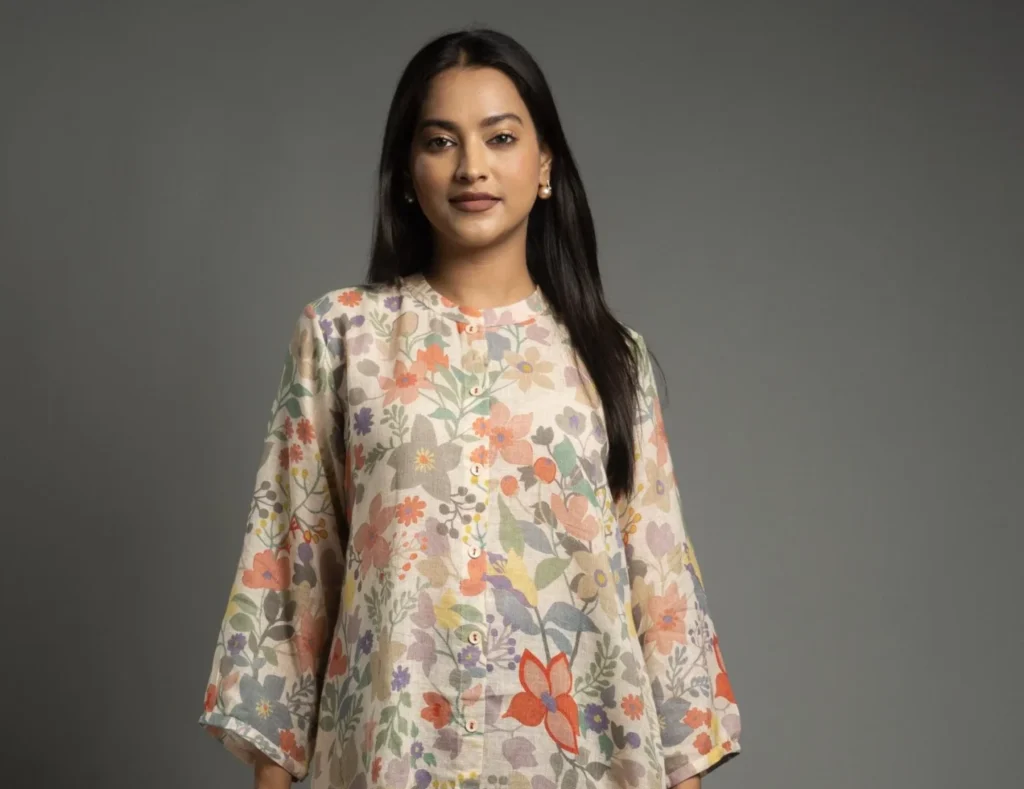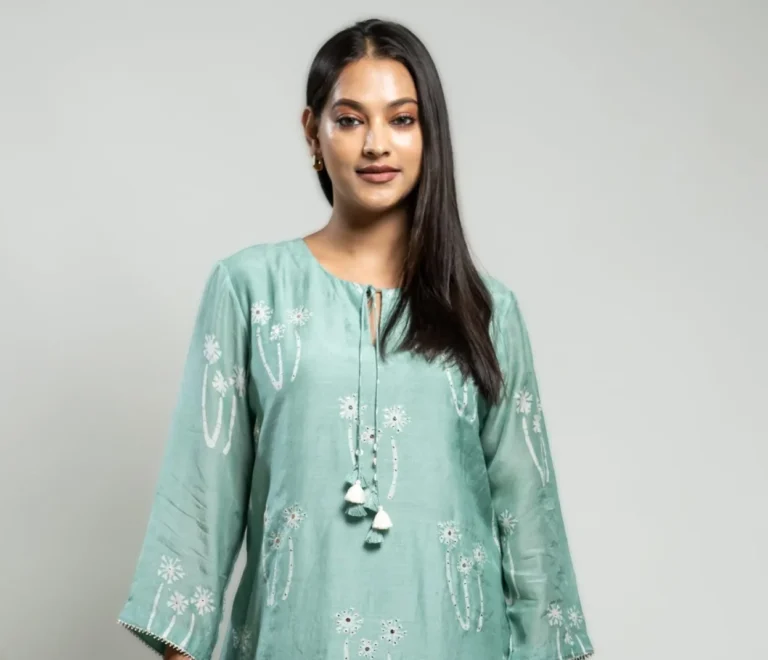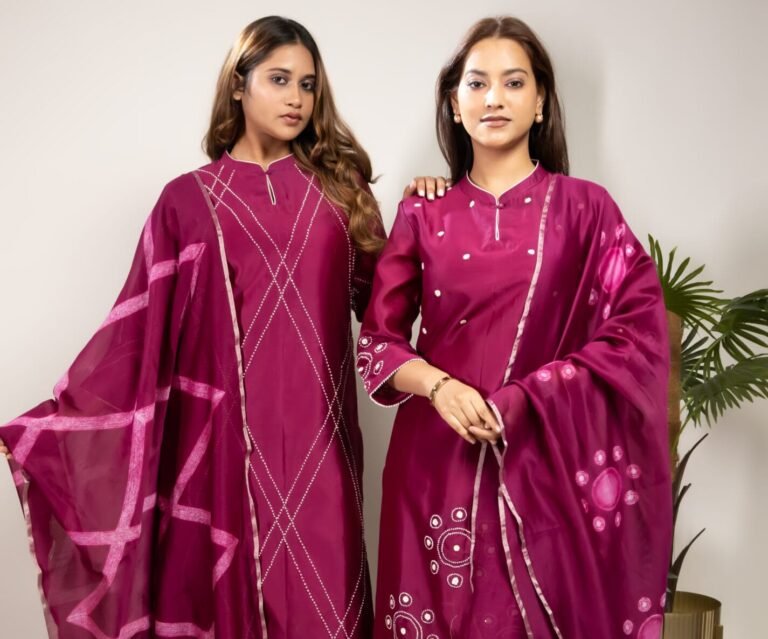
Everything You Need to Know About Linen Fabric
Source: ABC
For years, linen has epitomised an amalgamation of comfort, luxury, and elegance. Being a natural fabric made from the fibres of flax plant, it is utilised to make various sartorial accessories and apparel. Undeniably, it is every fashion connoisseur’s choice of fabric. Linen is not only a lightweight and soft fabric, but it also has a rich history and evolution. This blog will shed light on all the aspects you need to know about linen.
How is linen produced?
Linen fabric is produced from the cellulose fibres found inside the stalks of flax plants. It is an annual plant that survives for a single growing season. It gets prepared for being harvested in around a hundred days from the beginning of seed-planting. It requires less watering unless the climate is extremely dry or warm.
The plants are either drawn by hand or cut from the ground for fibre extraction. Afterwards, the seeds are taken out using a technique called ripping or sorting.
The next step is retting, which helps confiscate the stock of the plant from its fibres.
Once all the fibres are disseminated to accumulate the prolonged pieces with a length of up to 20cm, they are spun to make yarn that gets woven into fabric.
The Rich History and Evolution of Linen
Ancient Egyptian Linen with Ink Source: ABC
Between c. 6000 to c. 3150, linen was traded and exchanged in predynastic Egypt as part of the barter system. This exchange continued till Roman Egypt times. Flax was a crucial aspect of the Egyptian economy during those times as it had versatile applications from day attires to mummy bandages. Linen was suitable for the hot Egyptian weather; the credit goes to its absorbent and heat transmitting properties.
Subsequently, the mordants or dye-binding chemicals touched Egypt. Otherwise, the linen clothes would have been either natural or bleached white in colour.
Several other ancient Mediterranean cultures adopted the use of linen clothes, with Romans labelling the flax plant as “Linum usitatissimum,” or “most valuable flax.” Around 2,000 years later, linen chronicled its presence globally and was also exported to India, China, Persia, and Scotland.
Where is the best quality of linen fibre produced?
Initially, the linen trade touched Ireland, giving rise to a more systemised way to produce flax. In addition to Ireland, the best quality linen textiles also came from Belgium, France, and Italy. Owing to the soil quality and climatic conditions, Western Europe continues to be the producer of high-quality, extra-long flax fibres.
How did linen production begin in India? What was its impact on the people and economy?
The linen fabric production came to India with the opening of The Jaya Shree Textiles, established in 1949, as India’s first-ever manufacturing facility for linen. This textiles company is part of the esteemed Aditya Birla Group in India. In 1949, it set up the first integrated plant for producing linen in the country. It was well-equipped with world-class facilities with advanced Italian and Swiss systems for spinning, weaving, and exquisite finishing. The company launched Linen Club brand and popularised linen fabrics and clothing across India. The evolution of linen in the textile sector was sizeable, contributing to the betterment of the country’s economy.
Why is linen a desirable fabric?
Linen is considered a high-end fabric as it is breathable, cool, and blissful to wear. It is ideal for the times when the sun shines brighter on you. Linen helps you stay fashionable without compromising on comfort. Here are the reasons for which linen is touted as the most desirable fabric:
Hypoallergenic Fabric: Most people often suffer from allergies and skin ailments, and specific fabric types can often trigger the symptoms. Some fabrics let the moisture accumulate, leading to microbes and bacteria breeding. Speaking of the linen fabric, it is super breathable to enhance the airflow. As a result, it resists moisture effectively and prevents bacterial build-up. The clothes and bedding accessories made of linen are the perfect choices for those who experience uneasiness or itching due to sweat.
Long-lasting: Linen is amongst the strongest natural fibres worldwide. It is more sturdy than cotton, and linen’s thread reinforces the durability of the garment fabric. Thus the linen ensembles are long-lasting and stay anew for years. Moreover, garments crafted out of linen tend to maintain their shape even after many washes. They turn softer and more pleasant toward the skin as time passes by. Due to linen’s excellent resiliency, the linen attires do not disintegrate quickly.
Hassle-less Upkeep: Linen does not require any special care despite being a supreme fabric. It is compatible with machine wash on cold water rinse. Do not use strong bleach or chemical whiteners; instead, go for mild liquid detergents for gentle, safe and thorough washing of the garments. In case there is any special artwork on your linen fabric then it is best advised to follow the instructions on care label.
Ideal for All Seasons: Another great thing to consider about linen is its suitability for all seasons. It helps you stay cool in summers and warm during winters. Indeed, it is one of the heavenly benefits of donning linen. Typically, flax, through which the linen is made, is used for making insulation products for domestic applications. It is a natural insulator and releases the humidity effectively. Hence, the linen attires retain heat from the body and relieve the excess heat to make you feel relaxed and comfortable.
Handwoven Linen and Its Significance in Employment Generation for Artisan Community
Handwoven linen offers the potential to establish a fashion sector that is both environmentally friendly and supportive of craft communities. The handwoven linen resuscitates and treasures the timeless handcraft traditions.
Handwoven linen fabrics are created through manual weaving on a handloom. The handwoven linen thus produces a lesser carbon footprint. The artisans’ communities benefit from handwoven linen prospects. It helps support and facilitate the local businesses, enriching them financially and preserving weaving heritage.
The handwoven textile sector generates substantial employment opportunities for the artisan community to build and empower them, especially the women crafters.
The Difference Between Handwoven Linen and Machine Made Linen
The craftsmen generally produce hand-woven linen by incorporating their artisanal flair into hand-weaving techniques on a handloom. Contrary to this, machine-made linen is created with integrated automation technology through machinery. Here are the essential dissimilarities between the two:
Texture: During the handwoven process, the density of the woven thread and reed will determine the texture and weight of the apparel. The machine weaving will generate uniform textures, whereas the hand-weaving process can craft thin or thick textures depending upon the looming flair.
Uniformity: The machine-woven linen will always have an even texture, whereas the hand-woven linen will have a distinct texture. The art of manual crafting instils a uniqueness into every piece of garment. For instance, two handmade linen scarves would not be purely identical. Since the loom’s tap is operated by an artisan and not a machine, the loom generates fabric’s fall and character, weaving it distinctively each time.
Increased Weaving Complexity: Weaving flax fibres even on a machine is a complex and slow process (compared to cotton) as the fibres are easily breakable. The same problem compounds when weaving flax fibres on the handloom.
Sustainability: When it comes to sustainability, the hand-woven method is incomparable. Likewise, the handmade scarves and other ensembles made of linen are more environmentally conscious. The traditional process of weaving linen generates lesser waste and pollution, hence it is good for the ecosystem.
Ease of Personalisation: Since the artisan weaves every piece of linen clothing or accessory individually, it is easier to customise it as per the distinct fashion sense and choices. However, it is not that easy in the case of machine-made ones due to the creation of identical
The Use of Linen in the World of Fashion
The use of linen in the fashion universe is broad-ranging. It is among the most vital and preferable fabrics used to make a variety of apparel and accessories. Linen is also blended with premium materials such as cashmere and silk to craft high-end scarves and other fashion accessories.
Linen also makes up for a durable sewing thread that plays a pivotal role in making versatile types of garments. Linen is also widely combined with fabrics such as cotton and other regular materials to create daily-wear garments. Summer attires such as shirts, beach cover-ups, dresses, suits, scarves and trousers are made using linen.
Linen and its Love for Sustainability
Linen is one of the most durable and sustainable fabrics available on earth. When flax is grown, a minimal amount of water is needed. Moreover, flax does not require pesticides, fungicides, or herbicides in considerable quantities.
Linen Fabric: A Personification of Royalty and Unrivalled Beauty
The mention of linen clothing has been prominently seen in various sacred readings hailing from all the religions, with fifty-eight references in the Bible. During the medieval period, linen enjoyed immense popularity and adoration. It was eminent as the ensemble of royalty, personifying class and privilege.
Concluding Thoughts
Linen fabric is one of the most ancient fabrics discovered by mankind. It is venerated across the world for its purity, comfort, and durability. This fabric can be treasured for several years and still be in perfect condition. Unarguably, the apparels and accessories of linen are an ode to excellence.
Here’s a blog post about Linen Fabric Kurta for Women:(ai google)
Effortless Elegance: Why You Need a Linen Kurta in Your Wardrobe
Linen, with its airy lightness and natural beauty, has captivated fashion enthusiasts for centuries. And when it comes to women’s wear, a linen kurta emerges as a timeless and versatile piece that effortlessly blends comfort with style.
Why Choose Linen Kurta?
Breathability: Linen is renowned for its exceptional breathability. It allows your skin to breathe freely, keeping you cool and comfortable, especially during hot summer days.
Comfort: The soft and lightweight texture of linen drapes beautifully, providing a relaxed and comfortable fit.
Durability: Linen is a highly durable fabric that can withstand frequent wear and tear. With proper care, your linen kurta can last for years to come.
Versatility: Linen kurtas can be styled in countless ways. Dress them up with elegant jewelry and heels for a special occasion, or pair them with jeans and sandals for a casual everyday look.
Sustainability: Linen is an eco-friendly and sustainable fabric, making it a conscious choice for fashion-forward individuals.
Styling Your Linen Kurta:
Casual Chic: Pair your linen kurta with jeans, leggings, or palazzos for a relaxed and effortless look. Add a colorful scarf or a statement belt to accessorize.
Ethnic Elegance: Style your linen kurta with a pair of churidars, leggings, or a flowing skirt for a more traditional and elegant look. Complete the ensemble with jhumkas and bangles.
Modern Fusion: Experiment with modern silhouettes and styling. Try a short linen kurta with high-waisted pants or a longline kurta with a pair of shorts for a contemporary twist.
Caring for Your Linen Kurta:
Hand wash or gentle machine wash: Avoid harsh detergents and hot water.
Air dry: Avoid using a dryer, as it can shrink the fabric.
Iron while slightly damp: This will help to remove wrinkles easily.
Store properly: Fold your linen kurta neatly to prevent creases.
In Conclusion:
A linen kurta is a must-have addition to any woman’s wardrobe. Its timeless elegance, versatility, and comfort make it a perfect choice for various occasions. Embrace the natural beauty of linen and experience the effortless chic it brings to your style.
Note: This is just a basic template. You can expand on this by:
Including specific examples of linen kurta styles: Mention popular styles like Anarkali kurtas, straight kurtas, short kurtas, etc.
Here’s a blog post about Linen Fabric Kurta for Women, keeping it under 2000 words:
Effortless Elegance: Why You Need a Linen Kurta in Your Wardrobe
Linen, with its airy lightness and natural beauty, has captivated fashion enthusiasts for centuries. And when it comes to women’s wear, a linen kurta emerges as a timeless and versatile piece that effortlessly blends comfort with style.
Why Choose Linen Kurta?
Breathability: Linen is renowned for its exceptional breathability. It allows your skin to breathe freely, keeping you cool and comfortable, especially during hot summer days. This makes it a perfect choice for the warmer months.
Comfort: The soft and lightweight texture of linen drapes beautifully, providing a relaxed and comfortable fit. It moves with you, offering unparalleled ease of movement.
Durability: Linen is a highly durable fabric that can withstand frequent wear and tear. With proper care, your linen kurta can last for years to come, making it a sustainable and economical choice.
Versatility: Linen kurtas are incredibly versatile. Dress them up with elegant jewelry and heels for a special occasion, or pair them with jeans and sandals for a casual everyday look. You can effortlessly transition from day to night with just a few accessory changes.
Sustainability: Linen is an eco-friendly and sustainable fabric, making it a conscious choice for fashion-forward individuals. It is derived from the flax plant, a renewable resource, and its production process has a lower environmental impact compared to some other fabrics.
Styling Your Linen Kurta:
Casual Chic: Pair your linen kurta with jeans, leggings, or palazzos for a relaxed and effortless look. Add a colorful scarf or a statement belt to accessorize. You can also try a pair of white sneakers or colorful juttis for a more bohemian vibe.
Ethnic Elegance: Style your linen kurta with a pair of churidars, leggings, or a flowing skirt for a more traditional and elegant look. Complete the ensemble with jhumkas, bangles, and a bindi for a touch of ethnic flair.
Modern Fusion: Experiment with modern silhouettes and styling. Try a short linen kurta with high-waisted pants or a longline kurta with a pair of shorts for a contemporary twist. Add a pair of statement earrings or a sleek necklace to complete the look.
Office Wear: A well-fitted linen kurta with straight pants or a pencil skirt can make for a stylish and professional office attire. Pair it with minimal accessories and closed-toe shoes for a polished look.
Caring for Your Linen Kurta:
Hand wash or gentle machine wash: Avoid harsh detergents and hot water. Use a gentle detergent specifically designed for delicate fabrics.
Air dry: Avoid using a dryer, as it can shrink the fabric. Hang your linen kurta to air dry in a shaded area.
Iron while slightly damp: This will help to remove wrinkles easily. Use a medium heat setting on your iron.
Store properly: Fold your linen kurta neatly to prevent creases. You can also hang it on a padded hanger to maintain its shape.
In Conclusion:
A linen kurta is a must-have addition to any woman’s wardrobe. Its timeless elegance, versatility, and comfort make it a perfect choice for various occasions. Embrace the natural beauty of linen and experience the effortless chic it brings to your style.
Note: This blog post provides a concise overview of linen kurtas. You can further enhance it by:
Including specific examples of linen kurta styles: Mention popular styles like Anarkali kurtas, straight kurtas, short kurtas, etc.
Adding high-quality images: Visuals are crucial for fashion blog posts.
Sharing styling tips with different accessories: Discuss options like scarves, jewelry, footwear, and bags.
Mentioning where to buy linen kurtas: Share links to online stores or mention local boutiques.


